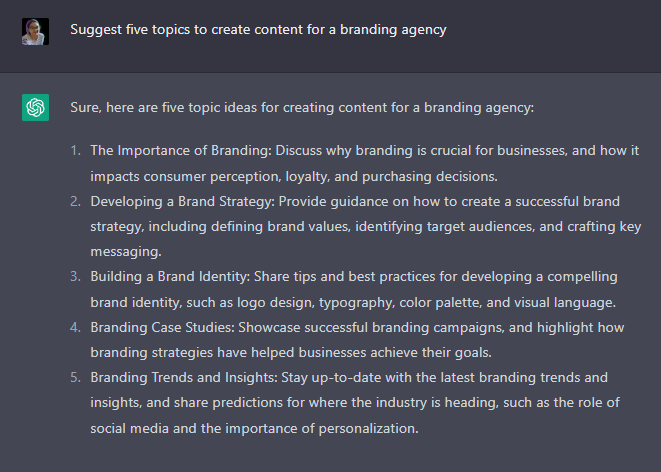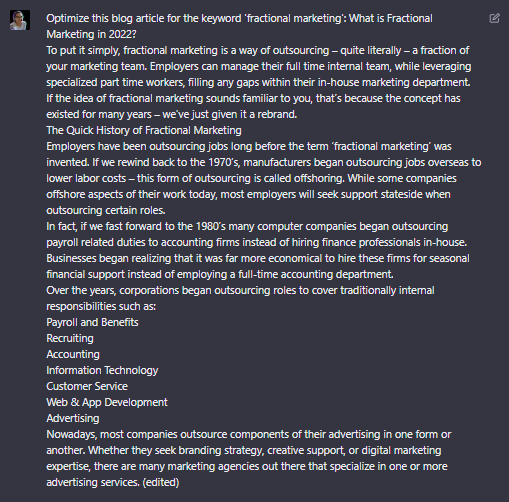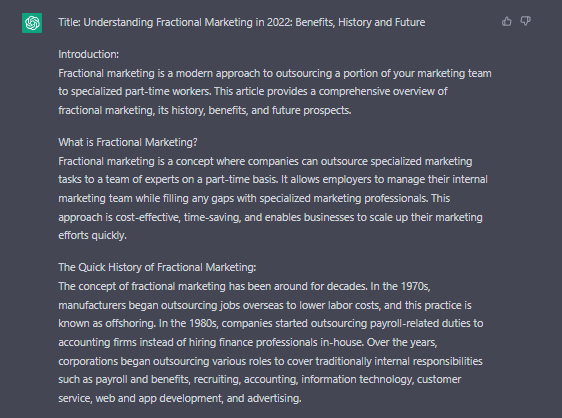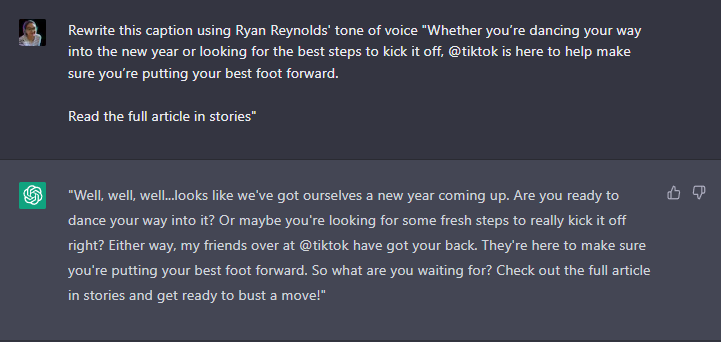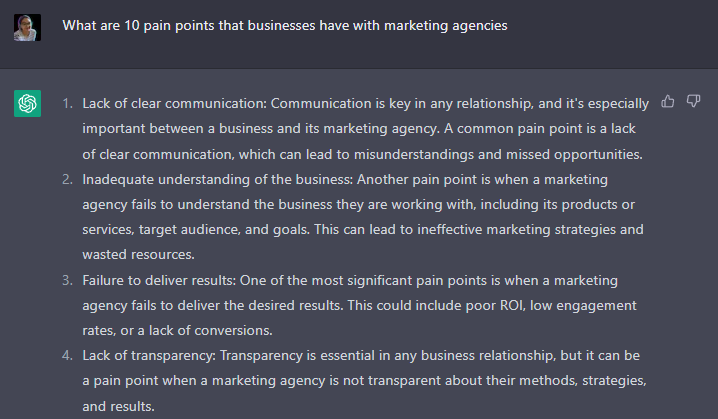For the past few months, ChatGPT has been a hot topic among strategists. Developed by OpenAI, this AI chatbot is designed to interact with users in a human-like manner, making it a revolutionary tool for marketers looking to communicate more efficiently with their audiences.
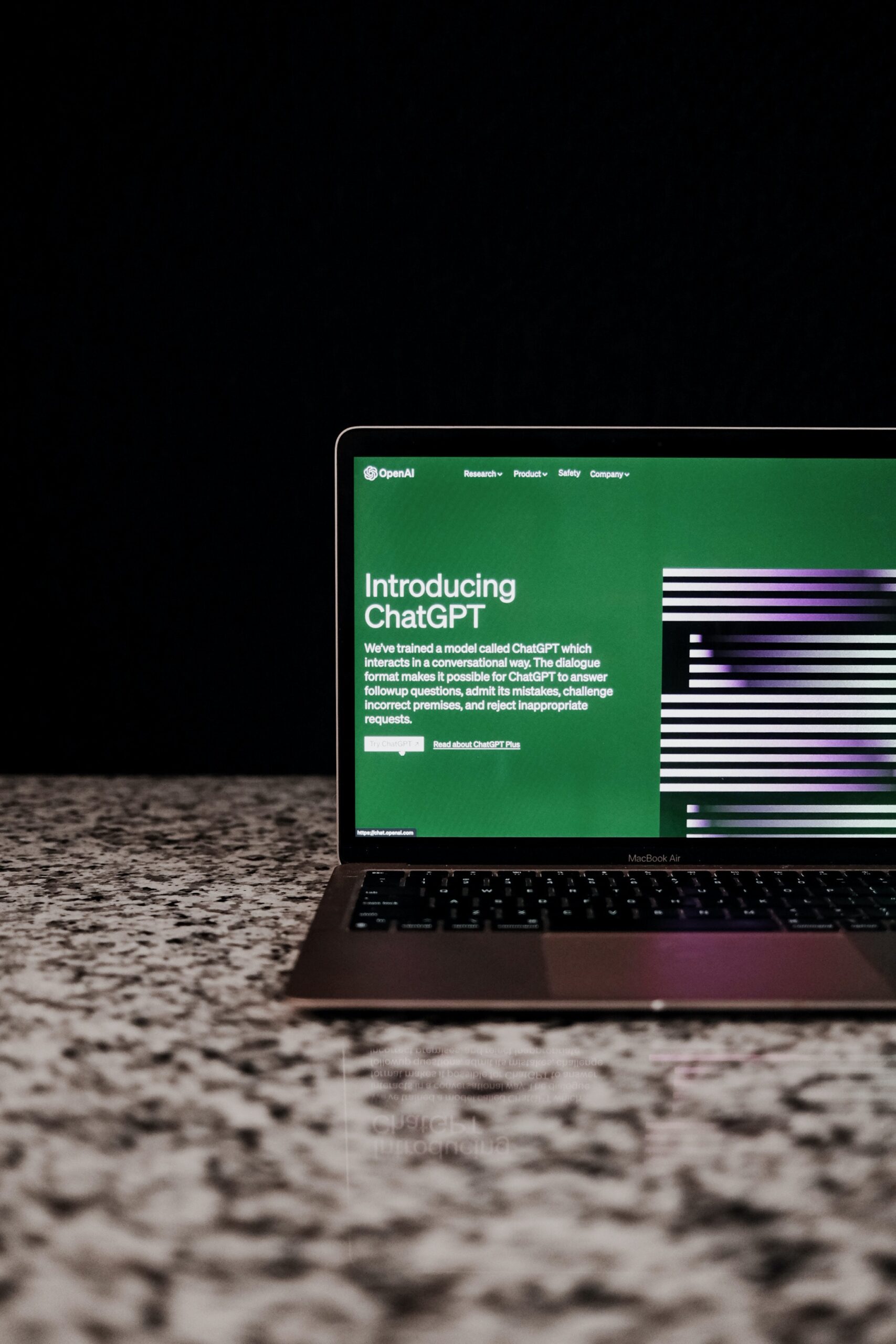
One of the cool things about ChatGPT is that it can help you craft unique content for all your marketing channels including emails, product descriptions, FAQs, surveys, ad copy, landing page copy, and beyond. It can even double as a brainstorming partner, generating a list of ideas or content outlines on a specific topic. For example, you could ask it to generate a list of blog titles on ‘artificial intelligence in marketing.’ 😏
But, and this is a big “but”, you need to be careful not to rely too heavily on a bot like this (or any bot for that matter). While ChatGPT can help content creators overcome writer’s block and generate ideas, simply copy-pasting what it serves you will ultimately lead to a very dry, poor quality (and potentially plagiarized) piece of content that won’t engage your readers. It’s important that you leverage a tool like this in order to make your marketing processes more efficient. Don’t over-rely on AI platforms like ChatGPT because it will ultimately hurt your marketing efforts in the long run. That said, we’ve put together a list of creative ways to incorporate ChatGPT into your ongoing marketing strategy.
- Using ChatGPT for Content Ideation: Level up your brainstorming with AI! At the end of the day, ChatGPT essentially functions as a smart search engine. Complement your original content ideas with thought-starters from ChatGPT. You can ask it to suggest a wide range of ideas and topics.

- Using ChatGPT for Content Ideation: Level up your brainstorming with AI! At the end of the day, ChatGPT essentially functions as a smart search engine. Complement your original content ideas with thought-starters from ChatGPT. You can ask it to suggest a wide range of ideas and topics.
- Using ChatGPt for Content Outlines: Beyond topic ideas, ChatGPT can write entire blogs, manifestos, website copy, and many forms of content! While this is incredibly useful, it’s not the best practice to use unedited AI-generated content for a number of reasons. However, ChatGPT can and should be used to outline copy across mediums and come up with unique headers, meta descriptions, and more.

- Using ChatGPt for Content Outlines: Beyond topic ideas, ChatGPT can write entire blogs, manifestos, website copy, and many forms of content! While this is incredibly useful, it’s not the best practice to use unedited AI-generated content for a number of reasons. However, ChatGPT can and should be used to outline copy across mediums and come up with unique headers, meta descriptions, and more.
- Using ChatGPT for Keyword Research: You can also incorporate ChatGPT into your SEO strategy. ChatGPT can recommend keyword targets for a particular topic. It can also crawl a URL and tell you potential keywords that a particular webpage is targeting. It’s important to note that ChatGPT is not meant to replace an SEO strategist, but is another tool a marketer can add to their arsenal.

- Using ChatGPT for Keyword Research: You can also incorporate ChatGPT into your SEO strategy. ChatGPT can recommend keyword targets for a particular topic. It can also crawl a URL and tell you potential keywords that a particular webpage is targeting. It’s important to note that ChatGPT is not meant to replace an SEO strategist, but is another tool a marketer can add to their arsenal.
- Using ChatGPT for Content Optimization: In addition to keyword recommendations, ChatGPT can optimize existing content. By providing instructions to the bot, ChatGPT can optimize your content for a specific keyword. It can even provide optimized title tags, meta descriptions, and headers.

Asked Chat GPT to optimize this blog

This is Chat GPT’s response
- Using ChatGPT for Tone and Voice Ideas: A fun way to use ChatGPT is by playing around with its voice and tone capabilities. For example, you can even ask ChatGPT to take an existing piece of content and rewrite it in the voice of a celebrity or character like Ryan Reynolds, Ron Swanson, or Snoop Dogg.

- Using ChatGPT for Content Optimization: In addition to keyword recommendations, ChatGPT can optimize existing content. By providing instructions to the bot, ChatGPT can optimize your content for a specific keyword. It can even provide optimized title tags, meta descriptions, and headers.
- Using ChatGPT for Email Marketing: While we don’t recommend using ChatGPT to write your email copy, you can use it for thought-starters around email subject lines or preview text. By fusing ChatGPT ideas and your email marketer’s best practices, you can efficiently generate unique subject lines for your emails.

- Using ChatGPT for Email Marketing: While we don’t recommend using ChatGPT to write your email copy, you can use it for thought-starters around email subject lines or preview text. By fusing ChatGPT ideas and your email marketer’s best practices, you can efficiently generate unique subject lines for your emails.
- Using ChatGPT for Social Media Captions: On the social media front, ChatGPT can save you time by writing unique captions for all your posts, within the exact character limits, and adding catchy call-to-actions and relevant tags. It can even be used for translations– helping you fine-tune messaging for international audiences.

- Using ChatGPT for Social Media Captions: On the social media front, ChatGPT can save you time by writing unique captions for all your posts, within the exact character limits, and adding catchy call-to-actions and relevant tags. It can even be used for translations– helping you fine-tune messaging for international audiences.
- Using ChatGPT for Market Research: Again, ChatGPT is like a smart search engine in many ways. You can use it to conduct market research by analyzing customer feedback, survey responses, and social media conversations. ChatGPT can even provide insights into consumer trends, product preferences, and brand sentiment. That said, ChatGPT does have its limitations and can occasionally generate incorrect information, so be sure to always double-check your findings. At the end of the day, ChatGPT should never be used as a cited source or reference for your work, but as a starting point to conduct further research across other platforms.

- Using ChatGPT for Market Research: Again, ChatGPT is like a smart search engine in many ways. You can use it to conduct market research by analyzing customer feedback, survey responses, and social media conversations. ChatGPT can even provide insights into consumer trends, product preferences, and brand sentiment. That said, ChatGPT does have its limitations and can occasionally generate incorrect information, so be sure to always double-check your findings. At the end of the day, ChatGPT should never be used as a cited source or reference for your work, but as a starting point to conduct further research across other platforms.
As with all technology, there are limitations. ChatGPT cannot access the internet in real-time in its base model or give location-based information, and its memory isn’t always reliable. It also has a restriction on how much text you can feed into it, and plagiarism remains a major limitation. So, until AI developers roll out an optimized version, tried-and-true digital marketing strategies are still the way to go. Marketers should leverage this tool to save time and brain power, not replace best practices. Stay creative and stay human!

And if ChatGPT is the only “marketer” in your wheelhouse right now, try partnering with an experienced team of marketing strategists to help promote brand awareness and drive ROI. Giant Propeller is a full-service brand growth and digital marketing agency. We provide customized solutions for your budget and business goals. Learn more about how Giant Propeller can elevate your holistic marketing efforts today. Propel your brand to new heights.
